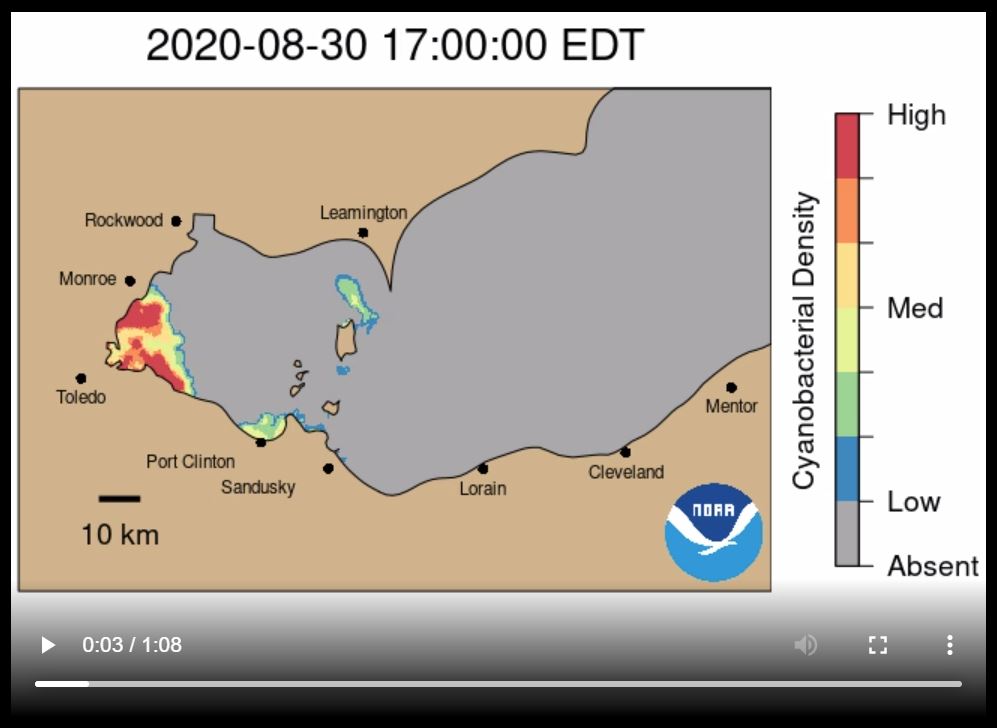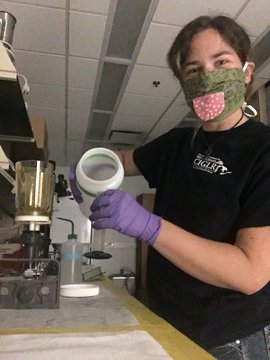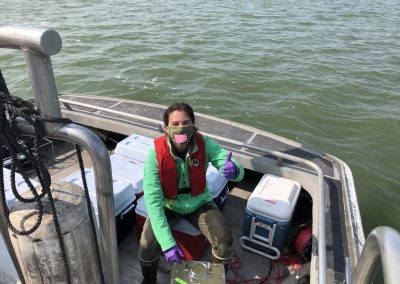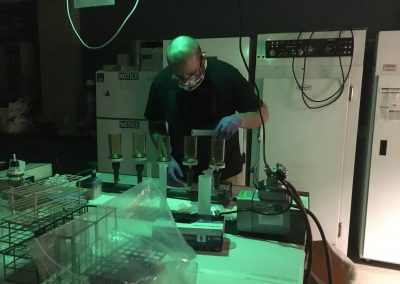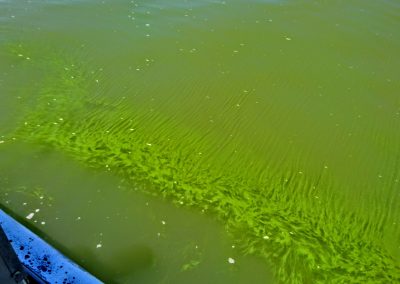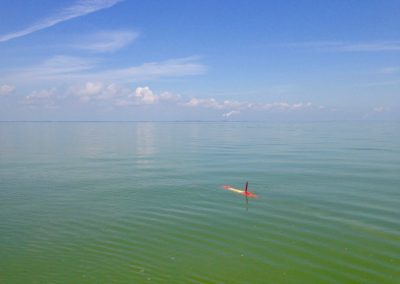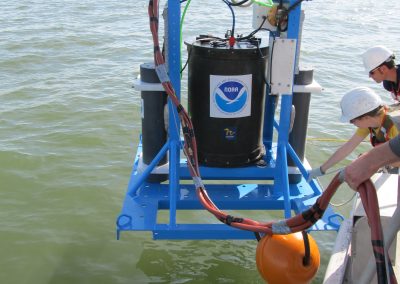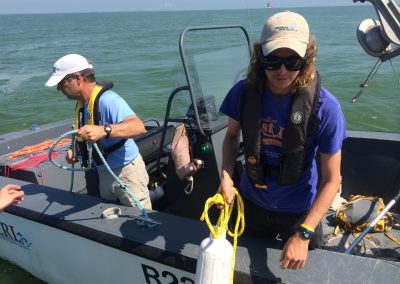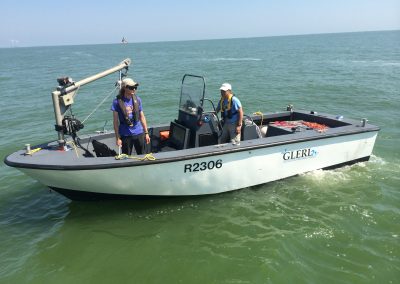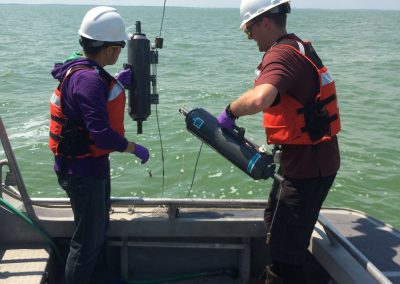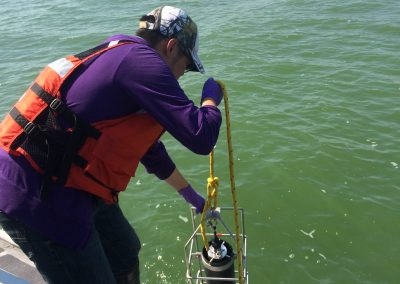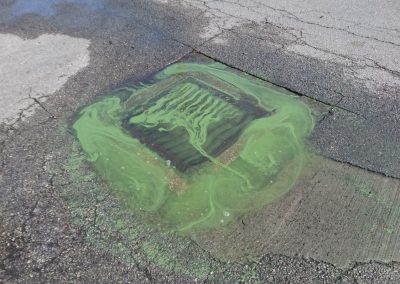Harmful Algal Blooms (HABs)
Harmful algal blooms (HABs) are scientifically complex, economically damaging, and a threat to ecosystem and human health.
Harmful algal blooms (HABs) are formed by dense populations of cyanobacteria (sometimes called blue green algae) that can produce toxins, threaten public health, and contribute to economic losses that exceed $2 billion annually. The Toledo water crisis in summer 2014 illustrated this threat, when a “do not drink” advisory was issued for unsafe levels of the harmful algal toxin microcystin in treated drinking water drawn from Lake Erie. With more than 400,000 people lacking drinking water for 2 days, the incident was reported worldwide and placed a spotlight on Lake Erie algal blooms as a threat to drinking water quality.
With our partners at NOAA GLERL, CIGLR is at the forefront of monitoring and forecasting HABs in Lake Erie, for the protection of human and ecosystem health. Our HAB research activities include:
1. Monitoring Harmful Algal Blooms
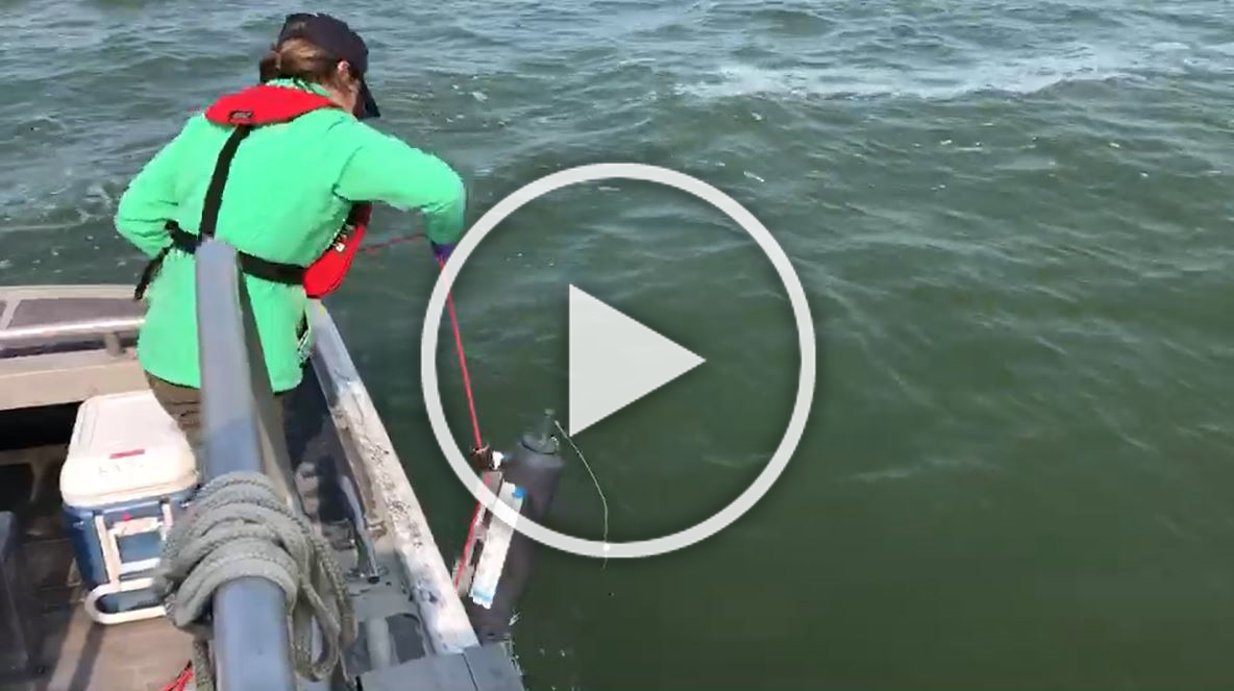
Click on the image to watch CIGLR’s Aquatic Ecology Research Analyst Holly Kelchner collect water with a Niskin Bottle Sampler from Lake Erie. This sample is used to analyze a suite of water quality parameters from the lake.
Water quality observations are essential for documenting the growth and spread of HABs. CIGLR and NOAA GLERL conduct regular field sampling in western Lake Erie and Saginaw Bay of Lake Huron during the July-October bloom season (field season is May-October). We sample and analyze temperature, Secchi disk transparency, algal parameters (chlorophyll, phycocyanin, phytoplankton abundance, algal toxins (microcystins and saxitoxins), and nutrients (phosphorus, nitrogen, carbon). We perform laboratory genetic tests to detect toxic populations of cyanobactera and determine how HABs are responding to water temperature and nutrients. Buoys and sensors deployed in western Lake Erie provide continuous water quality data during the bloom season. Data are available to the public for years 2009 to present (weekly monitoring) and 2014 to present (continuous systems).
In 2017, NOAA GLERL and CIGLR began field deployments of the first 2nd Generation Environmental Sample Processor (2G ESP) to be used in fresh water. The ESPniagara is an underwater robotic laboratory, or “lab in a can”, that collects and analyzes water for microcystin and communicates the results to data servers at GLERL in near-real time. Traditional lab techniques to determine algal toxin levels take days to complete. The ESPniagara provides drinking water managers with an earlier warning of algal blooms and their toxicity, enabling them to take action to protect public health sooner. The ESPniagara is deployed 5 miles west of the Toledo drinking water intake structure to get an early warning of elevated toxicity levels encroaching from Maumee Bay. Despite these advances, 2G ESPniagara‘s fixed mooring fails to fully support the information needed to predict HAB toxicity and fulfill the needs of drinking water intake managers. To fill this gap, a project team consisting of CIGLR, NOAA GLERL, NOAA National Centers for Ocean Coastal Science (NCCOS), and Monterey Bay Aquarium Research Institute (MBARI) is testing a new mobile HAB detection technology that will facilitate toxin forecasting and genomic observations at much greater frequency and in more areas of the lake. A new mobile 3G ESP will allow for weeks of flexible and targeted sampling, providing near real-time toxin and genomics measurements for integration into Lake Erie HAB toxicity forecasting products.
2. Predicting Future HABs
CIGLR and NOAA scientists use water quality data along with satellite data, weather forecasts, and water movement forecasts to predict future HABs in western Lake Erie. They have developed a specialized tool called the Lake Erie HAB Forecast (formerly the Experimental Lake Erie HAB Tracker) that gives current bloom conditions and a 5-day forecast of algal bloom movement and size through 3D simulations and graphics. These predictions can provide stakeholders, such as drinking water intake managers, commercial fishing operators, and beach goers, with timely information for public health decision making. Our team is currently using observed data to improve 3D prediction capabilities and developing methods to incorporate toxin concentrations into the model.
We are developing a new model for Lake Erie to examine relationships between HABs and key environmental factors like water temperature, river flows, nutrient loads, water column mixing, and sediment resuspension. Outcomes from the various loading-response scenarios will be used to develop relationships between nutrient loads and HABs in western Lake Erie.
3. Great Lakes 'Omics
Improvement of cyanobacterial Harmful Algal Blooms (cHABs) products is vital for protecting human health and is key for furthering our understanding of the possible connection between toxin potential, bloom toxicity, and environmental conditions. However, through ‘omics techniques we may be able to connect the presence of the microcystin gene with microcystin concentration and environmental conditions.
Scientists from CIGLR and NOAA GLERL are working together to provide further targeted investigations on the effects of environmental conditions on microcystin production in the lake. This project will provide critical information on HAB diversity, biology, and toxicity and will advance our knowledge of bloom ecology. It will improve our understanding of key traits associated with Microcystis’ life history strategies and impacts on the food web and society.
4. Incorporating Human Dimensions
To meet the needs of coastal communities, public health officials, and local water quality managers and decision-makers, the research team includes social scientists that are addressing the human dimensions of HABs in the Great Lakes. With the development and dissemination of our research products, we serve a wide range of users both public and private who shape the health and quality of the Great Lakes. The overall goals of this work are to: 1) identify and assess user needs related to water quality and human-health forecasting; 2) disseminate NOAA/CIGLR research, tools, and technology to end users to educate and build a network that will utilize NOAA products and information for decision making; and 3) guide the development and refinement of research project products.
The human dimensions team is conducting primary research that expands models of HABs and their impacts on water quality, with social dimensions that predict human behavioral responses to HABs or their impact on coastal communities. In addition to primary research, the team is leading outreach and stakeholder engagement efforts that facilitate the co‐design of research between scientists and stakeholder groups. They work with key user groups (e.g. drinking water managers, local officials, beach managers) and the general public to develop research into data products, like HAB forecasts and monitoring updates, that are easy to use and incorporate into user decision-making. They are also forging partnerships and networks with new stakeholder groups, including the recreational and charter fishing communities in the Great Lakes, through the use of human dimensions frameworks.
Learn more about our HABs focused stakeholder workshops and events by following this link.
Stay up-to-date on the most recent news and scientific media generated from our HABs research here:
Products
Resources
- Harmful Algal Blooms (HABs) and Hypoxia (CIGLR factsheet)
- HABs Research at NOAA GLERL (NOAA GLERL factsheet)
- Harmful Algal Blooms in the Great Lakes (NOAA GLERL factsheet)
- NOAA GLERL HABs main page (website)
- Environmental Sample Processor (ESP) (website)
- Harmful Algal Blooms Research (bookmark)
News
- U-M CIGLR’s Research Staff Provide Critical Information on Lake Erie’s Harmful Algal Blooms During COVID-19 Pandemic, University of Michigan School for Environment and Sustainability News, 11/9/2020
- NOAA improves harmful algal bloom forecasts with new 3-D model, NOAA Research News, 7/7/2020
- Fighting polarization in algae bloom controversy, Great Lakes Echo, 2/12/2020
- Researchers, residents working on new tools for tracking algae in Saginaw Bay, Great Lakes Connection Connexion Grands Lacs, 1/14/2020
- Editorial: Protecting the Great Lakes — From Parched Places Far Away and Algae Blooms Within, Chicago Tribune, 11/21/2019
- NOAA is Developing Underwater Robots to Map, Measure Toxicity of Great Lakes Algal Blooms, NOAA Research News, 8/14/2019
- Great Lakes buoys help fight algal blooms, and they just returned to the water, Fox 2 Detroit, 5/24/2019
- Monitoring algal blooms in the Great Lakes Basin, Great Lakes Echo, 2/13/2019
- Lake Erie algal blooms ‘seeded’ internally by overwintering cells in lake-bottom sediments, Michigan News, 11/21/2018
- Some cyanobacteria survive the winter in western Lake Erie, Michigan Radio, 11/21/2018
- Study: toxic algae develops faster, Great Lakes Echo, 11/21/2018
- Fishing in greener waters: Understanding the impact of harmful algal blooms on Lake Erie anglers, Michigan News, 9/12/2018
- Inside NOAA’s tracking of Lake Erie’s harmful algal bloom, WXYZ-TV Detroit | Channel 7, 7/25/2018
- Mussel ‘spits out’ toxic microcystin, plays part in Erie algae, 13 ABC, 6/7/2018
- Algal blooms harder to control because of climate change, other factors, data shows, The Blade, 5/1/2018
- Kapszukiewicz goes after Farm Bureau, legislature at algae conference, The Blade, 5/2/2018
- U.S. Rep. Dingell: I tried to sway Kasich to move faster on Lake Erie’s impairment, The Blade, 5/2/2018
- Underwater Robot Labs Monitor Toxins; Smithsonian.com, 8/10/2017
- Underwater Lab Helps Fight Lake Erie Algae; The Wall Street Journal, 7/24/2017
- New robotic lab tracking toxicity of Lake Erie algal bloom; Michigan News,7/19/2017
- Algae Bloom Tracker Developed by Anglers & Boaters (Radio Interview); Afternoon News on iheartradio, 7/14/2017
- New Tool for the Tackle Box: An Algal Bloom Tracker; Great Lakes Connection, 7/10/2017
- Severe algae bloom forecast; The Advertiser-Tribune, 2/17/2017
- Scientists launch “lab in a can” to detect toxins in Lake Erie; Michigan Radio, 9/15/16
- A “lab-in-a-can” could pioneer protection network for Great Lakes water; Great Lakes Echo, 9/9/16
- NOAA, partners predict smaller harmful algal bloom for western Lake Erie; NOAA.gov, 7/7/2016
- Stay out of the scum, warns NOAA’s latest bulletin on Lake Erie’s Harmful Algal Bloom; Climate.gov, 8/19/2015
- Hear from the scientists who saw the Ohio algae blooms coming; PBS Online, 8/3/2014
- Lake Erie: big algae problems, more to come; Christian Science Monitor, 4/2/2013
- Record-Setting 2011 Lake Erie Algae Blooms Could Become The New Norm; RedOrbit, 4/2/2013
- 2011 Lake Erie algae bloom an omen of worse to come: report; CTVNews, 4/2/2013
- Report Predicts Ever-Bigger Lake Erie Algae Blooms; CBS Detroit, 4/2/2013
Publications
Berry, M.A., T.W. Davis, R.M. Cory, M.B. Duhaime, T.H. Johengen, G.W. Kling, J.A. Marino, P.A. Den Uyl, D. Gossiaux, G.J. Dick and V.J. Denef. 2016. Cyanobacterial harmful algal blooms are a biological disturbance to Western Lake Erie bacterial communities. Environmental Microbiology. 19:1149-1162. (DOI:10.1111/1462-2920.13640). [Altmetric Score]
Berry, M.A., J.D. White, T.W. Davis, S. Jain, T.H. Johengen, G.J. Dick, O. Sarnelle and V.J. Denef. 2017. Are oligotypes meaningful ecological and phylogenetic units? A case study of Microcystis in freshwater lakes. Frontiers in Microbiology. 8(365). (DOI:10.3389/fmicb.2017.00365). [Altmetric Score]
Bertani, I., C.E. Steger, D.R. Obenour, G.L. Fahnenstiel, T.B. Bridgeman, T.H. Johengen, M.J. Sayers, R.A. Schuchman and D. Scavia. 2017. Tracking cyanobacteria blooms: Do different monitoring approaches tell the same story? Science of The Total Environment. 575:294-308. (DOI:10.1016/j.scitotenv.2016.10.023). [Altmetric Score]
Bosse, K.R., M.J. Sayers, R.A. Shuchman, G.L. Fahnenstiel, S.A. Ruberg, D.L. Fanslow and A.M. Burtner. 2019. Spatial-temporal variability of in situ cyanobacteria vertical structure in Western Lake Erie: Implications for remote sensing observations. Journal of Great Lakes Research. 45:480-489. (DOI:10.1016/j.jglr.2019.02.003). [Altmetric Score]
Chaffin, J.D., T.W. Davis, D.J. Smith, M.M. Baer and G.J. Dick. 2018. Interactions between nitrogen form, loading rate, and light intensity on Microcystis and Planktothrix growth and microcystin production. Harmful Algae. (DOI:10.1016/j.hal.2018.02.001). [Altmetric Score]
Cory, R.M., T.W. Davis, G.J. Dick, T.H. Johengen, V.J. Denef, M. Berry, S.E. Page, S.B. Watson, K. Yuhas and G.W. Kling. 2016. Seasonal dynamics in dissolved organic matter, hydrogen peroxide, and cyanobacterial blooms in Lake Erie. Frontiers in Marine Science. V3, Article 54. (DOI:10.3389/fmars.2016.00054). [Altmetric Score]
Davenport, E.J., M.J. Neudeck, P.G. Matson, G.S. Bullerjahn, T.W. Davis, S.W. Wilhelm, M.K. Denney, L.E. Krausfeldt, J.M.A. Stough, K.A. Meyer, G.J. Dick, T.H. Johengen, E. Lindquist, S.G. Tringe and R.M.L. McKay. 2019. Metatranscriptomic Analyses of Diel Metabolic Functions During a Microcystis Bloom in Western Lake Erie (United States). Frontiers in Microbiology: Aquatic Microbiology. (DOI:10.3389/fmicb.2019.02081). [Altmetric Score]
Fang, S., D.D. Giudice, D. Scavia, C.E. Binding, T.B. Bridgeman, J.D. Chaffin, M.A. Evans, J. Guinness, T.H. Johengen and D.R. Obenour. 2019. A Space-Time Geostatistical Model for Probabilistic Estimation of Harmful Algal Bloom Biomass and Areal Extent. Science of The Total Environment. (DOI:10.1016/j.scitotenv.2019.133776).
Gill, D., M. Rowe and S.J. Joshi. 2018. Fishing in greener waters: Understanding the impact of harmful algal blooms on Lake Erie anglers and the potential for adoption of a forecast model. Journal of Environmental Management. (DOI:10.1016/j.jenvman.2018.08.074). [Altmetric Score]
Gobler, C.J., J.M. Burkholder, T.W. Davis, M.J. Harke, T. Johengen, C.A. Stow and D.B. Van de Waal. 2016. The dual role of nitrogen supply in controlling the growth and toxicity of cyanobacterial blooms. Harmful Algae. 54:87-97. (DOI:10.1016/j.hal.2016.01.010). [Altmetric Score]
Guo, T., E.C. Nisbet and J.F. Martin 2019. Identifying mechanisms of environmental decision-making: How ideology and geographic proximity influence public support for managing agricultural runoff to curb harmful algal blooms. Journal of Environmental Management. 241:264-272. (DOI:10.1016/j.jenvman.2019.04.021). [Altmetric Score]
Kitchens, C.M., T.H. Johengen and T.W. Davis. 2018. Establishing spatial and temporal patterns in Microcystis sediment seed stock viability and their relationship to subsequent bloom development in Western Lake Erie. Plos One. (DOI:10.1371/journal.pone.0206821). [Altmetric Score]
LaBuhn, Shelby and J. Val Klump. 2016. Estimating summertime epilimnetic primary production via in situ monitoring in an eutrophic freshwater embayment, Green Bay, Lake Michigan. Journal of Great Lakes Research. 42(5):1026-1035. (DOI:10.1016/j.jglr.2016.07.028). [Altmetric Score]
Liu, Q.; M.D Rowe; E.J. Anderson; C.A. Stow; R.P. Stumpf and T.H. Johengen. 2020. Probabilistic forecast of microcystin toxin using satellite remote sensing, in situ observations and numerical modeling. Environmental Modelling and Software. (DOI:10.1016/j.envsoft.2020.104705). [Altmetric Score]
Meyer, K.A., T.W. Davis, S.B. Watson, V.J. Denef, M.A. Berry and G.J. Dick. 2017. Genome sequences of lower Great Lakes Microcystis sp. reveal strain-specific genes that are present and expressed in western Lake Erie blooms. PLoS One (DOI:10.1371/journal.pone.0183859). [Altmetric Score]
Michalak, A.M., E.J. Anderson, D. Beletsky, S. Boland, N.S. Bosch, T.B. Bridgeman, J.D. Chaffin, K.H. Cho, R. Confesor, I. Daloglu, J.V. DePinto, M.A. Evans, G.L. Fahnenstiel, L. He, J.C. Ho, L. Jenkins, T.H. Johengen, K.C. Kuo, E. Laporte, X. Liu, M. McWilliams, M.R. Moore, D.J. Posselt, R.P. Richards, D. Scavia, A.L. Steiner, E. Vaerhamme, D.M. Wright and M.A. Zagorski. 2013. Record-setting algal bloom in Lake Erie caused by agricultural and meteorological trends consistent with expected future conditions. Proceedings of the National Academy of Sciences. 110(16):6448-6452. (DOI:10.1073/pnas.1216006110). [Altmetric Score]
Millie, D.F., G.R. Weckman, G.L. Fahnenstiel, H.J. Carrick, E. Ardjmand, W.A. Young II, M. Sayers and R.A. Shuchman. 2014. Using artificial intelligence for CyanoHAB niche modeling: discovery and visualization of Microcystis-environmental associations within western Lake Erie. Canadian Journal of Fisheries and Aquatic Sciences. 71:1642-1654. (DOI:10.1139/cjfas-2013-0654). [Altmetric Score]
Moore, T.S., J.H. Churnside, J.M. Sullivan, M.S. Twardowski, A.R. Nayak, M.N. McFarland, N.D. Stockley, R.W. Gould, T.H. Johengen and S.A. Ruberg. 2019. Vertical distributions of blooming cyanobacteria populations in a freshwater lake from LIDAR observations. Remote Sensing of Environment. 225:347-367. (DOI:10.1016/j.rse.2019.02.025).
Moore, T.S., C.B. Mouw, J.M. Sullivan, M.S. Twardowski, A. Burtner, A.B. Ciochetto, M.N. McFarland, A.R. Nayak, D. Paladino, N. Stockley, T.H. Johengen, A.W. Yu, S.A. Ruberg and A. Weidemann. 2017. Bio-optical Properties of Cyanobacteria Blooms in Western Lake Erie. Frontiers in Marine Science. (DOI:10.3389/fmars.2017.00300). [Altmetric Score]
Newell, S.E., T.W. Davis, T.H. Johengen, D. Gossiaux, A. Burtner, D. Palladino and M.J. McCarthy. 2019. Reduced forms of nitrogen are a driver of non-nitrogen-fixing harmful cyanobacterial blooms and toxicity in Lake Erie. Harmful Algae. 81:86-93. (DOI:10.1016/j.hal.2018.11.003). [Altmetric Score]
Obenour, D.R., A.D. Gronewold, C.A. Stow and D. Scavia. 2014. Using a Bayesian hierarchical model to improve Lake Erie cyanobacterial bloom forecasts. Water Resources Research. 50(10):7847-7860. (DOI:10.1002/2014WR015616). [Altmetric Score]
Reavie, E.D., M. Cai, M.R. Twiss, H.J. Carrick, T.W. Davis, T.H. Johengen, D. Gossiaux, D.E. Smith, D. Palladino, A. Burtner and G.V. Sgro. Winter–spring diatom production in Lake Erie is an important driver of summer hypoxia. 2016. Journal of Great Lakes Research. 42(3):608-618. (DOI:10.1016/j.jglr.2016.02.013). [Altmetric Score]
Rowe, M.D., E.J. Anderson, T.T. Wynne, R.P. Stumpf, D.L. Fanslow, K. Kijanka, H.A. Vanderploeg, J.R. Strickler and T.W. Davis. 2016. Vertical distribution of buoyant Microcystis blooms in a Lagrangian particle tracking model for short-term forecasts in Lake Erie. Journal of Geophysical Research: Oceans. 121:5296-5314. (DOI:10.1002/2016JC011720). [Altmetric Score]
Rowland, F.E., C.A. Stow, T.H. Johengen. A.M. Burtner, D. Palladino, D.C. Gossiaux, T.W. Davis, L.T. Johnson and S. Ruberg. 2019. Recent Patterns in Lake Erie Phosphorus and Chlorophyll a Concentrations in Response to Changing Loads. Environment, Science, and Technology. (DOI:10.1021/acs.est.9b05326). [Altmetric Score]
Sayers, M.J. K.R. Bosse, R.A. Shuchman, S.A. Ruberg, G.L. Fahnenstiel, G.A. Leshkevich, D.G. Stuart, T.H. Johengen, A.M. Burtner and D. Palladino. Spatial and temporal variability of inherent and apparent optical properties in western Lake Erie: Implications for water quality remote sensing. Journal of Great Lakes Research. 45:490-507. (DOI:10.1016/j.jglr.2019.03.011). [Altmetric Score]
Sayers, M.J., A.G. Grimm, R.A. Shuchman, K.R. Bosse, G.L. Fahnenstiel, S.A. Ruberg and G.A. Leshkevich. 2019. Satellite monitoring of harmful algal blooms in the Western Basin of Lake Erie: A 20-year time-series. Journal of Great Lakes Research. 45:508-521. (DOI:10.1016/j.jglr.2019.01.005). [Altmetric Score]
Scavia, D., J.D. Allan, K.K. Arend, S. Bartell, D. Beletsky, N.S. Bosch, S.B. Brandt, R.D. Briland, I. Daloglu, J.V. DePinto, D.M. Dolan, M.A. Evans, T.M. Farner, D. Goto, H. Han, T.O. Hook, R. Knight, S.A. Ludsin, D.M. Mason, A.M. Michalak, R.P. Richards, J.J. Roberts, D.K. Rucinski, E.S. Rutherford, D.J. Schwab, T. Sesterhenn, H. Zhang and Y. Zhou. 2014. Assessing and addressing the re-eutrophication of Lake Erie: Central basin hypoxia. Journal of Great Lakes Research. 40:226-246. (DOI:10.1016/j.jglr.2014.02.004). [Altmetric Score]
Stauffer, B.A., H.A. Bowers, E. Buckley, T.W. Davis, T.H. Johengen, R. Kudela, M.A. Mcmanus, H. Purcell, G.J. Smith, A. Vander Woude and M.N. Tamburri. 2019. Considerations in Harmful Algal Bloom Research and Monitoring: Perspectives From a Consensus-Building Workshop and Technology Testing. Frontiers in Marine Science. (DOI:10.3389/fmars.2019.00399). [Altmetric Score]
Steffen, M.M., T.W. Davis, R.M. McKay, G.S. Bullerjahn, L.E. Krausfeldt, J.M.A. Stough, M.L. Neitzey, N.E. Gilbert, G.L. Boyer, T.H. Johengen, D.C. Gossiaux, A.M. Burtner, D. Palladino, M.D. Rowe, G.J. Dick, K.A. Meyer, S. Levy, B.E. Boone, R.P. Stumpf, T.T. Wynne, P.V. Zimba, D. Gutierrez and S.W. Wilhelm. 2017. Ecophysiological Examination of the Lake Erie Microcystis Bloom in 2014: Linkages between Biology and the Water Supply Shutdown of Toledo, OH. Environmental Science and Technology. 51(12):6745-6755. (DOI:10.1021/acs.est.7b00856). [Altmetric Score]
Stumpf, R.P., T.W. Davis, T.T Wynne, J.L. Graham, K.A. Loftin, T.H. Johengen, D. Gossiaux, D. Palladino and A.M. Burtner. 2016. Challenges for mapping cyanotoxin patterns from remote sensing of cyanobacteria. Harmful Algae. 54:160-173. (DOI:10.1016/j.hal.2016.01.005).
Vanderploeg, H.A., Sarnelle, O., Liebig, J.R., Morehead, N.R., Robinson, S.D., Johengen, T.H., Horst, G.P. 2017. Seston Quality Drives Feeding, Stoichiometry and Excretion of Zebra Mussels. Freshwater Biology. 62:664-680. (DOI:10.1111/fwb.12892). [Altmetric Score]
Vander Woude, A., S. Ruberg, T.H. Johengen, R. Miller and D. Stuart. 2019. Spatial and temporal scales of variability of cyanobacteria harmful algal blooms from NOAA GLERL airborne hyperspectral imagery. Journal of Great Lakes Research. (DOI:10.1016/j.jglr.2019.02.006). [Altmetric Score]
Zhang, H., L. Boegman, D. Scavia, D.A. Culver. 2016. Spatial distributions of external and internal phosphorus loads in Lake Erie and their impacts on phytoplankton and water quality. Journal of Great Lakes Research. 42:1212-1227. (DOI:10.1016/j.jglr.2016.09.005). [Altmetric Score]
PrincipaI Investigators:
Gregory Dick (CIGLR)
Casey Godwin (CIGLR)
NOAA Technical Leads:
Reagan M. Errera (NOAA GLERL)
Mark Rowe (NOAA GLERL)
Steven Ruberg (NOAA GLERL)
HABs Photo Gallery
Harmful Algal Blooms, HABs are a threat to human & ecosystem health. Here, Holly Kelchner (CIGLR) works in lab to help continue critical HABs monitoring & forecasting in Lake Erie. Photo Credit: Holly Kelchner.
Aquatic Ecology Research Analyst Holly Kelchner (CIGLR) collects water for the 2020 Lake Erie water quality observations. Photo Credit: Kent Baker.
Water quality obs are essential for documenting the growth/spread of harmful algal blooms, HABs. Here, Glenn Carter (CIGLR) filters for chlorophyll-a, an indicator of phytoplankton abundance & biomass in water. Photo Credit: Glenn Carter.
Michele Wensman (CIGLR) adds algae to 200 gallons of lake water to measure its bio-optical properties. This data helps describe the algal groups present when looking at satellite & hyperspectral images of the Great Lakes. Photo Credit: NOAA GLERL.
Algal surface scum on Western Lake Erie during harmful algal bloom (HABs) sampling. Photo Credit: Dack Stuart.
3G ESP in the water! It was deployed in 2018 for targeted sampling, providing near real-time toxin and genomics measurements for integration into Lake Erie HAB toxicity forecasting products. Photo Credit: Paul Den Uyl.
Emily Davenport (CIGLR, left), Timothy Davis (BGSU, middle) and Roman Marin ( Monterey Bay Aquarium Research Institute, right) prepare to deploy the autonomous laboratory ESPniagara in western Lake Erie on July 11. Photo Credit: Mike Wood of Michigan News.
Kyle Beadle (NOAA GLERL, left), and Emily Davenport (CIGLR, right) prepare to lower ESPniagara from the deck of a research vessel into western Lake Erie on July 11. Photo Credit: Mike Wood of Michigan News.
Emily Davenport (CIGLR) guides the ESPniagara autonomous laboratory as it is lowered into western Lake Erie on July 11 to measure microcystin toxins produced by cyanobacteria. Photo Credit: Mike Wood of Michigan News.
Danna Palladino (NOAA GLERL) retrieves the buoy portion of the ESPniagara robotic laboratory after a test deployment in western Lake Erie last fall. Photo Credit: Daryl Marshke of Michigan Photography.
The ESPniagara being lowered into Lake Erie for its first test deployment. This is the first ESP to be deployed in the Great Lakes. Photo Courtesy of NOAA.
Harmful algae bloom in Bolles Harbor, Monroe, MI, Lake Erie. July 22, 2011. Cyanobacteria blooms, or HABs, can grow rapidly and produce toxins, which can cause harm to humans and animals. Photo Credit: NOAA.
Dack Stuart (CIGLR) and Russ Miller (CIGLR) sampling during a harmful algal bloom event. Sampling cruises are completed weekly during bloom season to collect water samples, deploy marine instrumentation (SeaBird CTD, fluoroprobe) and collect hyperspectral measurements using digital imaging and light intensity. Photo Courtesy of NOAA.
Dack Stuart (CIGLR) and Russ Miller (CIGLR) working and preparing sampling equipment for HABs sample collection. Photo Credit: NOAA.
Former Masters student Tonghui Ming and former CIGLR postdoc Kevin Meyer sampling water using Niskin bottles during a harmful algal bloom event. Dr. Meyer was studying freshwater HABs (mostly cyanobacteria) in the Great Lakes using a variety of genetic and bioinformatic tools. His research interests and goals were to better understand the drivers of bloom formation, termination, and toxicity so that innovative and effective management strategies can be implemented to reduce the impact of HABs on the Great Lakes and surrounding communities. Photo Credit: NOAA.
Former SNRE masters student Tonghui Ming collecting water quality data. This data helped tell the researchers more about harmful algal bloom characteristics. Photo Credit: NOAA.
Former CIGLR postdoc Kevin Meyer collecting water samples using a Niskin bottle. The team was out sampling the water during a harmful algal bloom event. Photo Credit: NOAA.
Former masters student Tonghui Ming and former CIGLR postdoc Kevin Meyer processing samples. Dr. Meyer used these samples to better understand the impact of HABs on the Great Lakes and surrounding communities. Photo Credit: NOAA.
A bottle of the harmful algae, Microcystis, collected during weekly sampling in the Great Lakes. Photo Credit: CIGLR.
Video Library
A new tool to safeguard drinking water is now keeping a watchful eye on Lake Erie. A robotic lake-bottom laboratory tracks levels of dangerous toxins produced by algae that bloom each summer in the lake’s western basin. The goal is to provide advance warning to municipal water managers and thereby prevent a recurrence of the water crisis that left more than 400,000 Toledo-area residents without safe drinking water for about two days in early August 2014 due to high levels of microcystin toxins.
fdgj
Let’s meet CIGLR Aquatic Ecology Research Technician, Christine Kitchens. In a CIGLR Minute Christine highlights her harmful algal blooms (HABs) work & research & talks about what she enjoys most about her job & working on the Great Lakes.

